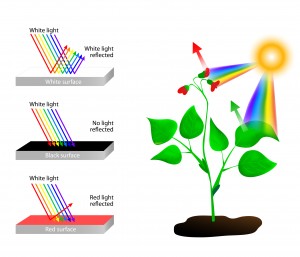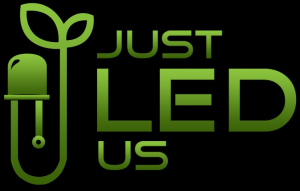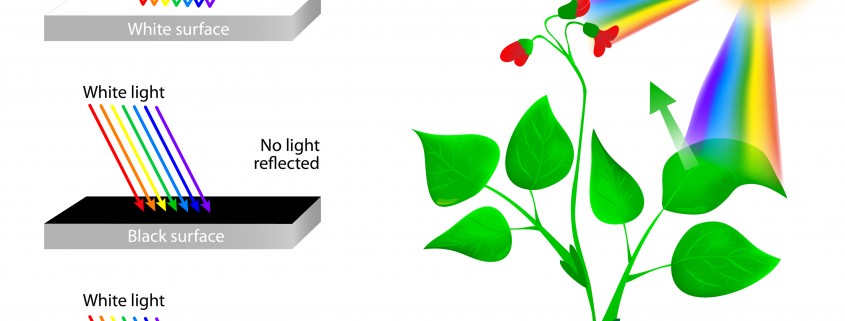Photoreceptors and Spectral Absorption
A plants development is dependent on the environmental conditions where it is growing. Light is not only a substrate for photosynthesis but a stimulus that regulates a wide range of metabolic and developmental processes, including seed germination, leaf development, stem extension, phototropism, gravitropism, chloroplast movement, shade avoidance, circadian rhythms and floral induction. Light is the energy source for plant growth, plants have evolved highly sensitive mechanisms for perceiving light and they use that information for regulating developmental changes to help maximize light utilization for photosynthesis. The process by which plant development is controlled by light is called photomorphogenesis. Typically, photomorphogenic responses are self-evident in germinating seedlings but light affects a plants development in many ways throughout all stages with the utilization by the way of spectral absorption.
We as humans assume white light, plants sense their needs through plot, zone, and micro climatization aspects of the environment they grow. Greenhouses, closed containment and or vertical systems all require considerations of micro climatization integration for best result crop yield, energy efficiency and efficacy, sustainability and plant morphology. Every lighting scene or recipe is crop specific, however the specificity is directly related to many environmental variables of micro-climatization efforts to maximize your crop production practices.
According to the European Union Intellectual Property Office, there is no way to claim rights for IP related to a recipe of light. However, multiple efforts using photonics can be enabled through use of polymers which can track and identify common flow behaviours through which can be used for commercial value. Commercializing, end to end Distribution programing may include the rescue of various components as well as enabling various on or offline considerations related to the operational grow environment & your key crop Ag Business.
Determining ‘the best’ lights or lighting conditions also include many other aspects. Static lighting is often a key in creating a dynamic recipe. After all we consider ‘white light’ because we perceive it through our perception as human beings. Each crop plant type has its own physiology, the environmental considerations are varied based on seasonality and result based oriented goals of the operator.
Static white light LEEDs is not a sustainable and efficient approach to apply across all plant types as per their physiology has unique needs. An array of varied colour spectrum is very important in accordance to your plants needs, considering the environment from which they grow. Lighting is a substrate, which is a component of micro climate in controlled agricultural system operations. The sun is dynamic, so should be solutions using the visual colour spectrum!

Photoreceptors and Spectral Absorption
Many full spectrum LED Ag tech lighting have predefined ratios of light (wavelengths) by the way of circuit on board technology which provides higher power density, more efficient heat dissipation, and requires a smaller portion of the board space because the chips are in the form of a semiconductor which is neither encased or connected directly. LED’s provide a fine balance of red and blue light to which plants are genetically attuned and also have a specific ratio of violet, indigo, blue(s), green, yellow, orange, orange–red, red(s) and far-red. Generally referred to as spectrum ranging from 380nm to 730nm.
In higher plants, the effects of light on plant development are controlled by several classes of photoreceptors.
The combined absorption spectra of the red/far-red light receptors (phytochromes) and the blue light receptors (cryptochromes and phototropins) overlap with those of the photosynthetic pigments, allowing coordinated control of development and energy production in plants.
The following spectral data is an outline which details the biological activity of general plant growth and responses which are dependent on specific spectral output. This will serve as a general reference and will also lead you toward an introduction to basic gene expression knowledge when using your static, digital or dynamic LED lighting systems for your growing environment and operations garnering optimization strategy. Note: Colour ratios vary based on Lighting Advancements.
Violet–Blue spectrum light is in the range of 380–455nm which increases the leafy area of your plants. UV reduces the invasion of white flies and thrips in your growing area or greenhouse. In reference to the sun, {UVA is in the range of 315–400nm and UVB is in the range of 280–315nm. Ultraviolet-B receptor UVR8 is an UV-B sensing protein found in plants and possibly other sources. It is responsible for sensing ultraviolet light in the range 280–315 nm and initiating the plant stress responses}. Too much UVB can cause plants colours to fade.
UVB affects a number of physiological processes including photosynthesis, through the effects of gene expression. Some plants have the ability to induce a number of defense mechanisms such as the production of UVB screening pigments, increased antioxidant enzymes and induction of pathogenesis related proteins. All effects from UVB are major macro-molecules and exposure can lead to irreversible effects including impairment and destruction of function within cells.
UVB can be a useful spectrum in plant physiology. For example, ultraviolet-B (UV-B) radiation impacts on the levels of a broad range of metabolites, including phenolic, terpenoid and alkaloid compounds. This includes several compounds that are pharmacologically active and nutritionally or medicinally important! More data is being released in regards to details about the impacts on the nutritional and pharmacological characteristics of plant biomass and byproducts.
UV light plays an important role in triggering plants to create physiological changes such as pigmentation, vitamins and other substances, and for certain the hydrocarbon secretion of many plants.
UVA/blue light perception is mediated by the cryptochromes which is a photoreceptor that regulates stomatal aperture in response to blue light.
Blue spectrum light is around the range of 400–470nm and are unique to plants as it mediates hypocotyl growth inhibition, leaf expansion, phototropism, stomatal opening and chloroplast movement or synthesis. The last step of chlorophyll synthesis requires high levels of blue light. Generally with blue light you will increase chlorophyll production and it will contribute to shorter and wider leaves. The other blue light responses are triggered by lower levels of blue light.
*Blue light fun fact: Blue light will increase the red pigmentation in red leaf lettuce.

Hypocotyl, Cotyledon, Epicotyl and True Leaves
Hypocotyl is a part of a germinating seedling of a seed plant. As the plant embryo grows at germination, it sends out a shoot called a radicle that becomes the primary root and penetrates down into the soil. After emergence of the radicle, the hypocotyl emerges and lifts the growing tip (usually including the seed coat) above the ground, bearing the embryonic leaves (called cotyledons) and the plumule that gives rise to the first true leaves. The hypocotyl is the primary organ of extension of the young plant and develops into the stem.
Blue photorecptors are responsible for Phototropins, LOV-domain proteins and Cryptochromes. Phototropins are photoreceptor proteins (specifically, flavoproteins) that mediate phototropism responses in higher plants. Along with cryptochromes and phytochromes they allow plants to respond and alter their growth in response to the environment.
Excess blue light has the opposite effect, producing plants that are short and stocky.
Green spectrum light is in the general range of 525–570nm and studies conclude that cryptochrome activity is a sensor of blue/green irradiance. Carotenoids absorb in the blue/green region. There is very little absorbance of green light in extracted chlorophyll molecules. However, as the integrity of the leaf increases there is more and more absorption in the green region, which means green light plays a minor role in light absorption and energy transfer to photosystems. There is a vast amount of conflicting information to discuss on the subject but, the question still remains. Is supplemental green light necessary for plant growth and development? Recent studies have determined that green light is photosynthetically efficient up to 30% absorption rate with low PPF.
Results are not very likely to apply to higher PPFs (e.g. 300 µmol m-2 s-1) as high green supplemental light will cause significant elongation of stems and thin, chlorotic leaves. Chlorosis is a condition in which leaves produce insufficient chlorophyll, this is a term used in the study of botany. As chlorophyll is responsible for the green color of leaves, chlorotic leaves are pale, yellow, or yellow-white. This is one way that green light affects plant biomass and reverses UV-B and blue light mediated stomatal opening. In treatments like these the plants were unable to establish a strong leaf canopy and their growth. But it is regarded as a true finding that very high photosynthetic photon flux (PPF) of supplemental green light levels will induce partial shade-avoidance responses.
Partial shade-avoidance responses are caused by the presence of neighboring vegetation. When the light environment is modified due to the incidence of one plant basically monopolizing light, other vegetation sometimes is not receiving an optimal amount of coverage of the emitted full spectrum light that is needed for photosynthesis in the regulation of plant development. Thus the plant begins to compete with its neighbour of its species and it goes into overdrive. To step out of their neighbours shade the plant switches on a natural chemical factory for synthesizing auxin, a hormone that enables them to stretch and grow toward the light source. This happens with all light source, whether it is a grow light or the sun.
Photosynthetically inefficient light qualities impart important environmental information to a developing plant. When a plant is experiencing partial shade avoidance responses they generate signals that are perceived by phytochromes and cryptochromes. These signals cause large changes in a plants body form and function, including enhanced growth of the hypocotyl and petioles, a more erect position of the leaves and early flowering.
Too much green light spectra will cause plants to sense shade, this is why High PAR LED grow lights work well with very few LEDs running in the green spectra.
“Other effects of the plant-shaded environment are less understood. A shaded environment is enriched with green wavebands (500-570nm) in the understory light milieu (Klein, 1992). These wavelengths, generally considered to be inconsequential to plants, affect the way that plants grow and adapt to the light environment. Leading up to the current millennium, the specific effects of green wavebands were occasionally reported in plants (Klein, 1992). Fungi, algae, and bacteria clearly exhibited green light responses, suggesting that analogous systems would be found in plants. A series of reports in the last decade have shown not only that green specific responses do exist, but also that they are oftentimes mediated by well-described light sensing systems (Banerjee et al,. 2007: Wang et al,. 2012). Genetic and/or photo-physiological experiments have shown that some green light responses are not easily attributed to the currently known suite of light receptors (Folta and Maruhnich, 2007; Goggin and Steadman, 2012).”
However, a plant ‘fed’ only green or yellow wavelengths would die as quickly as one kept in the dark.
Accessory pigments such as carotenes and xanthophylls harvest some green light and pass it on to the photosynthetic process, but enough of the green wavelengths are reflected to give leaves their characteristic color.
Yellow spectrum light is in the range of 570-590 and recent research shows that plants do absorb some green and yellow light and use it in the photosynthesis process. A light source that provides dynamic controls of light in the entire visible range will better meet the needs of the plant.
Amber–Orange spectrum light is in the range of 620–630nm mimics that of the sun helping plants grow quickly. Amber–Orange addresses photoreceptors linked to chlorophyll and increases plants chlorophyll contents.
Orange–Red spectrum light resides in the range of 630–642nm which allows for additional photo-receptors to utilize more wavelengths.
Red spectrum light is in the range of 640-680nm which is the usual highest concentration of light in most LED grow lights which provide for chlorophyll A and B, one of the most important wavelength ranges for primary plant grow and photosynthesis. But to note: Many experiments have shown that plants receiving excess red light become tall and spindly.
Generally red light will increase above ground biomass with longer and less wide leaves.
Far Infra-red spectrum light is in the range of 660-800nm which allow chlorophyll A and B to photosynthesize and helps your plants grow taller and healthier. The Emerson effect is the increase in the rate of photosynthesis after exposure to light of wavelength 670nm red light and 730nm far-red light respectively. When simultaneously exposed to light of both wavelengths, the rate of photosynthesis is far higher than the sum of the red light and far red light photosynthesis rates.
In basic terms, Infra-red diodes wake the plant up and put it to sleep. {When referencing natural light from the sun the ratio of red (640-680nm) to (740nm) far red is about 1.2:1. Phytochrome (Pfr) is a photoreceptor in higher plants which is responsible for the process of growth and development which are related to light – photomorphogenesis. Phytochrome monitors red and far-red regions of the electromagnetic spectrum which is activated at 640–680nm and Pr is activated by 730-740nm}. Spectral Absorption in this range widely influences photosynthesis; this is primarily where chlorophyll absorption occurs and is where phenological events such as flowering and fruiting can be observed. Many flowering plants use it to regulate the time of flowering based on the length of day and night (photoperiodism) and to set circadian rhythms.
Tags: #photoreceptors #spectrum #apbsorption #justledus #cryptochromes #plantcell #phototropin #proteins #responsetolight #lightresponses #thescienceoflight #environment #microclimatization #photoreceptors #plants #emersonenhancementeffect #phytochrome #circadianrhythm #photoperiodism #geneexpression #plants #phisiology #spectraloutput #lightspectrum #closedcontainmentagricluture #greenhousing #verticalfarming #veticalfoodsystems #optimization
Related Article: Chlorophyll
References:
Cryptochromes: http://www.plantcell.org/content/14/suppl_1/S207.full
Photoreceptors and plants http://www.plantphysiol.org/content/125/1/85
The Emerson Enhancement Effect and Two Light Reactions in Photosynthesis
http://www.life.illinois.edu/govindjee/Electronic%20Publications/1963/1963_Gov.pdf


